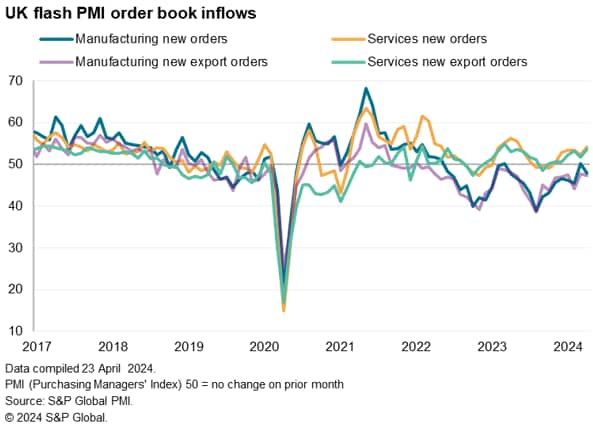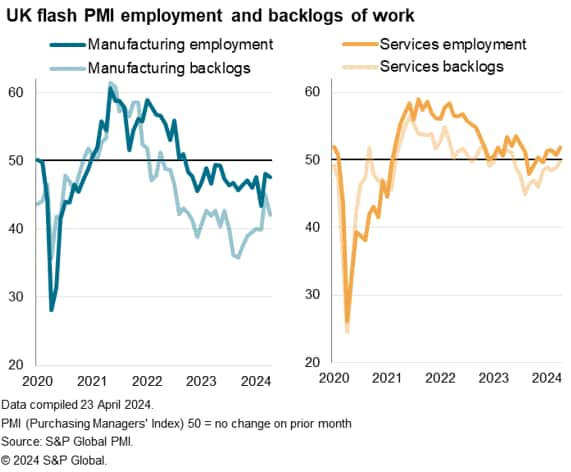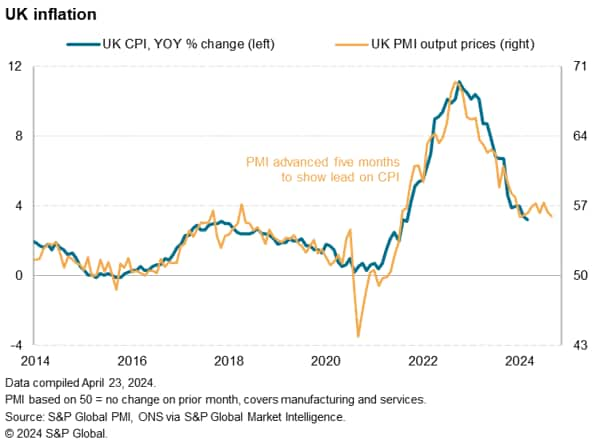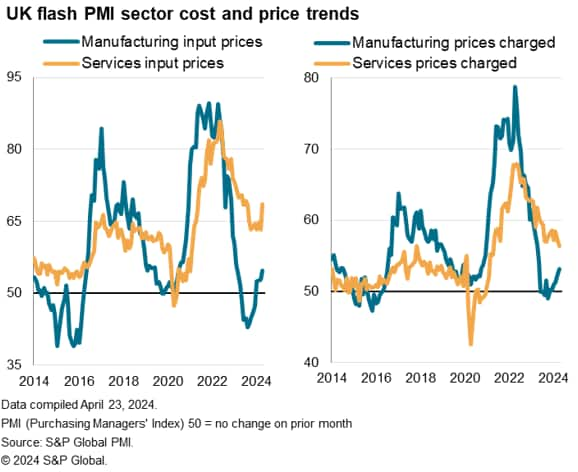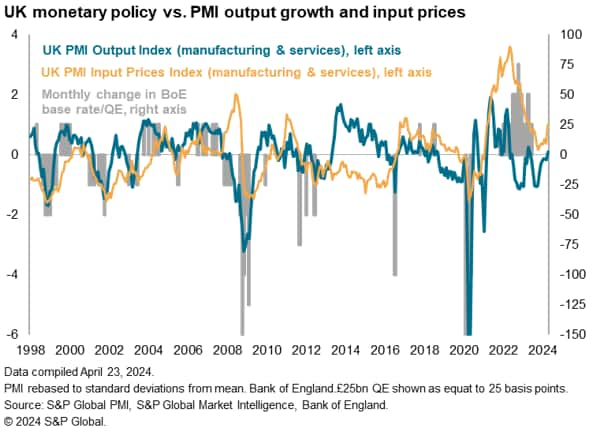Early PMI survey data for April indicate that the UK economy’s
recovery from recession last year continued to gain momentum.
Improved growth in the service sector offset a renewed downturn in
manufacturing to propel overall business growth to the fastest for
nearly a year, indicating that GDP is rising at a quarterly rate of
0.4% after a 0.3% gain in the first quarter.
The upturn encouraged firms to take on workers in increased
numbers which, alongside April’s rise in the National Living Wage,
drove cost pressures sharply higher. Although selling price
inflation cooled slightly, the upturn in costs alongside solid
demand suggests firms may seek to raise prices in the coming
months.
While the improving economic recovery picture is welcome news,
the upward pressure on inflation will add to concerns that a
sustainable path to below target inflation has not yet been
achieved.
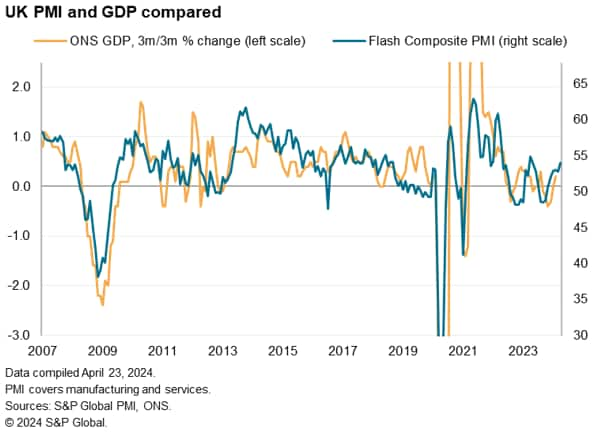
Economic growth at 11-month high
Business activity growth accelerated to an 11-month high in
April, according to early PMI survey indications. The headline
economic growth indicator from the flash PMI surveys, the
seasonally adjusted S&P Global UK Composite Output Index,
registered 54.0 in April against 52.8 in March. The latest reading
signals a sixth successive monthly expansion of output, with the
rate of growth rising to the highest since May of last year.
April’s expansion is broadly consistent with GDP growing at a
quarterly rate of almost 0.4% at the start of the second quarter,
building further on the robust 0.25% gain signalled by the PMI in
the first quarter.
The survey data therefore indicate that the UK economy continues
to pull out of the technical recession seen late last year,
recovering to register solid growth.
The latest official GDP are also showing signs of the recession
having ended, with monthly GDP having risen for a second successive
month in February. First quarter GDP data are so far also running
0.3% above the fourth quarter of last year, in line with the PMI
signal.
Services-driven growth while manufacturing
stabilises
April’s improvement was driven by the service sector, which as a
whole grew at the strongest rate seen for 11 months. Trends varied
markedly within services, however. The strongest performing sector
was financial services, followed by tech/IT, but only a modest gain
was recorded for business services, and other sectors such as
transport and hospitality reported falling output.
Falling output was also seen in the manufacturing sector,
reversing the modest return to growth in March (which had seen the
first increase in factory output for just over a year).
Elevated optimism – in the service sector
The improved business growth in April was accompanied by
continued elevated levels of optimism about the 12-month outlook.
Business expectations about the year ahead fell further from
February’s two-year high but remained well above the survey’s
long-run average, in part reflecting an accelerated rate of
increase of new orders, which rose at the sharpest pace for 11
months.
However, sector variations were again evident by sector in terms
of outlooks and order books. Manufacturing future sentiment fell to
a four-month low as new orders contracted after a marginal gain in
March, linked largely to lower exports, which have now fallen
continually for 27 months. In contrast, service sector future
sentiment lifted higher, amid increased rates of growth of both new
business and exports.
Hiring picks up
Hiring picked up on the back of the improved demand situation
and increased workloads, albeit with gains limited to the service
sector. Measured overall, employment rose for a fourth successive
month in April, rising at the fastest rate for nine months.
However, a steeper rate of jobs growth in the service sector was
countered by a slight acceleration in the rate of factory job
culling. While service sector payrolls have now risen for four
successive months, manufacturing headcounts have fallen continually
over the past 19 months.
Selling price inflation cools despite National Living
Wage adding to price pressures
Average selling prices charged for goods and services rose in
April at the slowest rate since last August, and the joint-slowest
rate since February 2021. The latest data nevertheless remain
elevated by historical standards, and broadly consistent with
inflation (headline CPI) running close to 4%. There were also some
notable details beneath the headline selling price number, which
hint at some possible renewed near-term upward pressure on
prices.
Encouragingly, service sector selling price inflation, which has
proven to be the most stubborn aspect of inflation in recent
months, slowed in April to a three-year low. However, service
sector input cost inflation jumped higher to hit a nine-month high,
buoyed in particular by higher wages.
It should be noted that the April PMI data include the impact of
the introduction of the latest
National Living Wage (NLW) increase. Effective from 1st April,
the recommended wage increased from £10.42 to £11.44, a rise of
9.8%.
Manufacturers’ selling prices meanwhile rose at the sharpest
pace since last May, as firms passed higher costs on to customers.
Manufacturing costs grew at the fastest rate since February 2023,
having now risen for four consecutive months after eight months of
continual decline.
In manufacturing, an additional cost driver was renewed raw
material supply shortages. April saw average supplier delivery
times lengthen for a fourth successive month, with delays again
often linked to Red Sea-related shipping disruptions. Longer
lead-times tend to be associated with higher prices as a reflection
of demand exceeding near-term supply, though the need to re-route
ships around Africa has also directly raised shipping costs so far
this year.
Average input costs across goods and services consequently rose
sharply in April, the rate of inflation surging to the highest
recorded since last May. The 4.8 point increase in the Composite
Input Cost index was the largest recorded since October 2021, and
represents a hike in costs that companies may seek to pass on to
some degree to customers in the coming weeks or months.
Not a rate cutting environment
The latest PMI data follow growing expectations that the Bank of
England may start cutting interest rates as soon as June. However,
the upturn in the pace of economic growth signalled by the PMI, and
the upsurge in firms’ cost pressures, suggest that business
conditions are more consistent with rate hikes rather than rate
cuts. Both the composite flash PMI output index and input cost
index are above their long run averages and rising.
Access the press release
here.
Chris Williamson, Chief Business Economist, S&P
Global Market Intelligence
Tel: +44 207 260 2329
© 2024, S&P Global. All rights reserved. Reproduction in
whole or in part without permission is prohibited.
Purchasing Managers’ Index™ (PMI®) data are compiled by S&P Global for more than 40 economies worldwide. The monthly data are derived from surveys of senior executives at private sector companies, and are available only via subscription. The PMI dataset features a headline number, which indicates the overall health of an economy, and sub-indices, which provide insights into other key economic drivers such as GDP, inflation, exports, capacity utilization, employment and inventories. The PMI data are used by financial and corporate professionals to better understand where economies and markets are headed, and to uncover opportunities.
This article was published by S&P Global Market Intelligence and not by S&P Global Ratings, which is a separately managed division of S&P Global.


